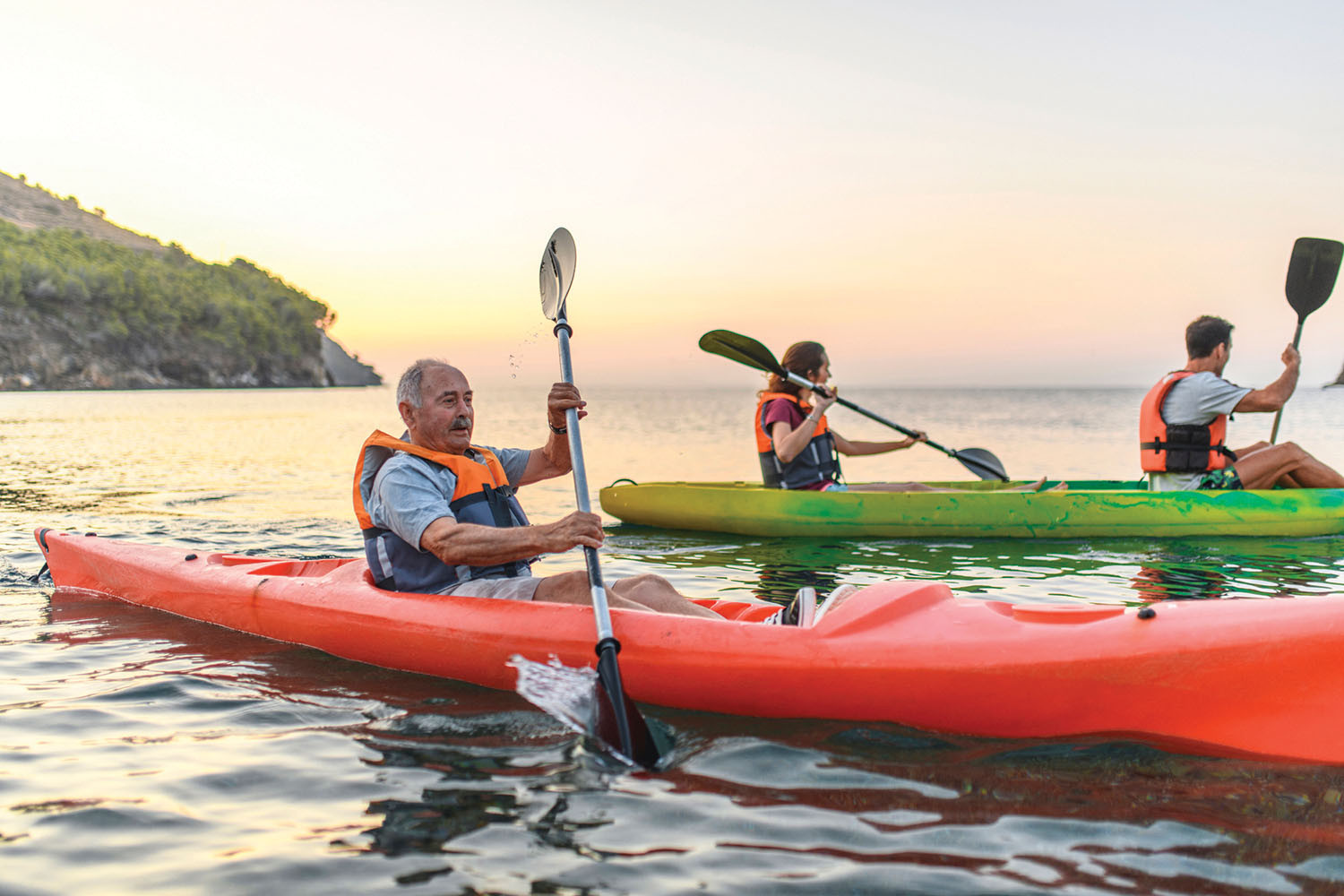Rowing or paddling after age 60
If you're new to these sports, or if you're returning to the water after time in dry dock, you'll want to know the risks.
- Reviewed by Anthony L. Komaroff, MD, Editor in Chief, Harvard Health Letter; Editorial Advisory Board Member, Harvard Health Publishing

There's something quite satisfying about dipping an oar or paddle into the water and pulling your craft along the surface. It's hard work that produces tangible results (moving from here to there). And when you add the calming element of nature and the camaraderie of working with others, rowing or paddling winds up being a great physical workout with many health benefits. Still, it comes with some risks to consider.
Types of activities
A variety of water sports involve either rowing or paddling. Rowing can be done with one or two oars. You can row in a long boat called a shell that accommodates two, four, or eight people; you operate just one oar in that setup. Or you can operate two oars in a smaller boat called a scull that accommodates one, two, or four people.
Paddling refers to water sports that use paddles. Single paddles, which have a flat blade at one end, are used in canoeing, dragon boat racing (with 10 or 20 people in a long canoe-like boat adorned with a dragon head and tail), and paddleboarding (standing or kneeling solo on a paddleboard, which looks like a wide surfboard).
A double paddle, which has a blade at both ends, is used in kayaking. Types of kayaks range from wide, flat recreational kayaks to long, skinny, streamlined kayaks called "surf skis" (a new trend among kayakers).
Benefits
Rowing and paddling have many health benefits.
They work your heart and lungs. Aerobic exercise helps build endurance and promotes cardiovascular health, mobility, better mood, and sharp cognition.
They use lots of muscle groups. "The activities are good for strength and coordination. Rowing mainly uses the legs and back, while paddling uses the core muscles to generate power for propulsion. Paddleboarding works the muscles in the buttocks and the sides of the trunk, and improves standing balance," explains Denise Frost, a long-time sculler, physical therapist, and director of Movement Health at Harvard-affiliated Spaulding Rehabilitation Hospital.
They promote socializing. Spending time with others counters isolation and loneliness, which are associated with chronic disease and premature death.
They help manage stress. Exercising and spending time in nature wards off chronic stress — a contributor to chronic inflammation, chronic disease, and premature death.
Risks after 60
While you might have jumped into a boat years ago, you need to use more caution now and consider the physical risks of rowing or paddling. "These sports have a repetitive component. Paddling can stress the shoulder tendons. Rowing can lead to low back strains," Frost says. "Neither sport is good idea if you already have tendinitis at the shoulder, elbow, or wrist; a diagnosed back problem such as a disc injury or spinal stenosis; or a previous back surgery."
The sports might also be risky if you're not a good swimmer, haven't exercised in a long time, or have a heart or lung condition. Check with your doctor before getting involved in either sport.
Getting started
If you're interested in paddling or rowing, Frost says paddling might be the smarter way to go, since it can be as easy or demanding as you make it. Rowing, however, has a longer learning curve and is more physically demanding than paddling, so you'll need to be in good shape to try it. You should also wear sunblock and sunglasses; stay hydrated; and (during summer) restrict your participation in the activity to early mornings or late afternoons, to avoid getting overheated.
If you want to try paddling, Frost recommends renting the type of boat (such as a canoe or kayak) that interests you and taking a lesson to see if you like it. For dragon boat racing or rowing, Frost says it would be best to join a local club that offers introductory courses and could place you in a boat with similarly experienced teammates.
And even though paddling and rowing may look easy, remember that it takes time to learn a new skill and develop coordination. "You may feel strain and stiffness in many parts of your body as it adapts to new demands and forces," Frost says. "So start slowly, with shorter sessions, and build up your tolerance."
Image: © AzmanL/Getty Images
About the Author

Heidi Godman, Executive Editor, Harvard Health Letter
About the Reviewer

Anthony L. Komaroff, MD, Editor in Chief, Harvard Health Letter; Editorial Advisory Board Member, Harvard Health Publishing
Disclaimer:
As a service to our readers, Harvard Health Publishing provides access to our library of archived content. Please note the date of last review or update on all articles.
No content on this site, regardless of date, should ever be used as a substitute for direct medical advice from your doctor or other qualified clinician.
















